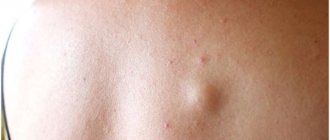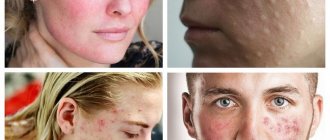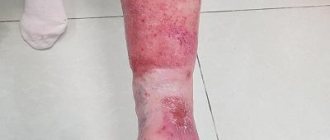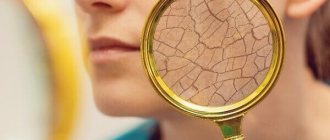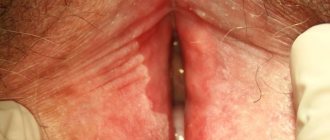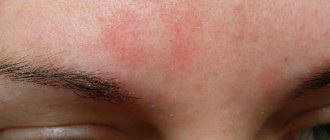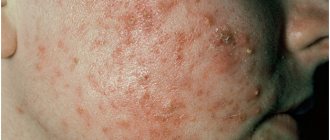Acne and its common consequence, post-acne, are a fairly acute and common dermatological problem. The term “acne” refers to acne or inflammation of the sebaceous glands and hair follicles, which is accompanied by the formation of numerous pimples of different sizes and types. Most often, this disease occurs in adolescents, lasts for years and is difficult to treat. Although it can also develop in adulthood, including after 30-35 years.
According to the latest data, more or less 85% of people suffer from acne, and in 15-30% of cases the disease is severe and requires complex, long-term complex treatment. Acne affects those areas of the skin where sebaceous glands are most concentrated. Therefore, very often it affects the face, which causes serious psychological complexes. But acne can also occur on other parts of the body, in particular the back. At the same time, one of the common complications of the disease is post-acne, i.e. persistent changes in the skin in the form of spots, and more often scars of different sizes, which are extremely difficult to deal with, but still possible.
What is acne?
Most often, the disease affects the skin of the face, upper back, chest, and less commonly the skin of the shoulders and forearms.
The problem of acne is especially relevant in adolescence, manifesting itself on the skin in the form of red inflammatory nodules, pustules, blackheads, and sometimes cysts. But now older people often suffer from acne. Quite often the disease appears in athletes who use steroid drugs.
Acne is a disease associated with increased sebum production and enlarged and clogged sebaceous glands. An inflammatory disease of the skin glands, most often localized in the face, back, and chest. According to the literature, acne occurs in approximately 85% of people aged 12 to 25 years, but in different populations these figures can vary between 35-90%. In people over 25 years of age, the incidence of the disease is 11%, and sometimes it occurs in patients over 40 years of age. Typically, patients of all races and both genders are affected by acne, but symptoms most often begin to appear during adolescence. Among older patients, women predominate. Currently, there are effective treatment methods that can significantly reduce the symptoms and even completely cure acne. In addition, cosmetic products and treatments can reduce or completely eliminate scars and skin discoloration associated with acne and pimples.
Classification
Chronic disease has a classification. It differs by the age of the patient.
| Age | Description |
| Youth | Formation of comedones, papules, pustules, cystic pimples, rapid development of acne |
| Adults | Acne: late, inverse, sports, spherical |
| Childhood | Acne in newborns, acquired in children |
The comedo form is a precursor to the papulopustular stage of acne development. Stable development from the age of 8. The indicator of greasiness and hair increases. Formation of microcomedones in the sebaceous glands, developing into a closed type.
The formation of the papulopustular form is characterized by a profuse rash over all parts of the body. Severe manifestations form scarring in damaged areas of the inflammatory process.
The nodular course complicates the disease with the rapid appearance of acne. Localization in the back area.
Causes:
- Genetics. A predisposition to acne can be inherited from close and not very close relatives. This is why some people don't take care of their skin, and acne doesn't attack them.
- Problems in the endocrine system. The glands produce more sebum, keratinization of the skin increases, and this, in turn, contributes to clogging of pores and the appearance of acne.
- Infection. Propionibacterium acnes (P. acnes) lives on the surface of the skin normally. It is this that promotes inflammation of clogged sebaceous glands.
- Improper skin care. It is very important to choose the right basic skin care products. Do not wash your face with soap or other alkaline detergents, as soap dries out the skin, dehydrates it, and degreases it. This makes the skin uncomfortable and, in order to protect itself and restore its barrier properties, it begins to produce sebum even more, aggravating the manifestations of the disease. For the same reasons, regular use of alcohol solutions and lotions to cleanse the skin also leads to increased sebum secretion.
- Diseases of the gastrointestinal tract. The mechanisms of this relationship may be different, and in some cases remain completely unknown.
- Smoking. It has been proven that acne in people who smoke is much more severe than in non-smokers.
- The influence of psycho-emotional overload. It is known that against the background of stress, sebum secretion increases, which worsens the course of acne.
Acne
often associated with pathology of internal organs. Problems with the stomach and intestines (ulcers, gastritis and colitis), as well as constipation, lead to an exacerbation of the disease and the appearance of new acne on the face. Acne on the face in the area of the nose, chin and cheeks may be associated with dysfunction of the gonads (more often in women with adnexitis). The disease is aggravated by ingestion of hot, spicy foods and alcoholic beverages. When there is a lack of female sex hormones estrogen in the body of women and an excess of male sex hormones, acne appears on the back, chest and face. Acne also occurs with long-term use of drugs containing iodine, bromine, corticosteroids, as well as with occupational contamination of the skin, for example, tar, tar, oil, chlorine compounds, etc. The term “acne” appeared among specialists not so long ago. He points out that the appearance of acne is not only the appearance of rashes on the skin, but also a change in the condition of the entire body. Acne has been described in athletes and bodybuilders taking anabolic drugs.
The etiopathogenesis of acne vulgaris is complex. The following factors play a major role in the development of the disease:
- overactivity of sebaceous jelly;
- keratinization of the mouth and blockage of the sebaceous glands;
- activity of saprophytic microflora of the skin;
- inflammatory process.
In the ducts of the sebaceous glands, microcomedones are formed - sebaceous-horn plugs, which do not manifest themselves clinically. Further accumulation of secretion and its pressure on the clogged funnel of the follicle leads to the formation of a cystic cavity in the lower part of the funnel of the hair follicle and the appearance of clinical signs of the disease in the form of closed comedones. The constant accumulation of sebaceous and horny masses inside the follicle and their pressure on the surrounding tissues ultimately leads to atrophy of the sebaceous gland, as well as to an expansion of the mouth of the hair follicle. This is how open comedones are formed.
According to modern concepts, bacteria are not the direct cause of the disease; they only provoke local inflammatory processes. Saprophytic microorganisms such as lipophilic fungi of the genus Pytirosporum, Staphylococcus epidermidis and Propionibacterium acnes are constantly present on the skin and hair follicles. The largest role in the development of inflammation in acne is played by Propionibacterium acnes - gram-positive, non-motile lipophilic rods that are facultative anaerobes. The blockage of the mouth of the hair follicle and the accumulation of sebum inside it create the preconditions for the proliferation of these microorganisms inside the funnel of the hair follicle. The constant proliferation of P. acnes in the follicle, which is detected at the microcomedone stage, leads to an increase in the activity of metabolic processes, and the consequence of this is the release of inflammatory mediators.
Most acne disease frequencies belong to the acne comedonica and acne papulopustulosa categories. All other types are much less common.
There are 4 degrees of acne severity:
- One or two areas of the face are affected. Open and closed comedones are observed with a significant predominance of open comedones. There are isolated superficial papules and pustules.
- Several areas of the face and body are affected. A large number of open and closed comedones. Single papules and pustules.
- Against the background of open and closed comedones, a large number of deep pustules and papules are diagnosed. Hyperemia of the affected areas is common due to a pronounced inflammatory reaction. There are post-acne phenomena: scars, stagnant spots, hyperpigmentation.
- Large (more than 5 mm in diameter) bluish-purple painful infiltrates, conglobate elements (several large nodes located nearby, connected by fistulous tracts), large cysts that resolve with the formation of rough atrophic scars are observed.
Types of acne
Acne vulgaris (acne vulgaris, juvenile acne, acne)
– a chronic disease of the sebaceous glands and hair follicles, develops against the background of age-related hyperfunction of the sebaceous glands under the influence of gonadotropic hormones, occurs in 85% of people aged 12 to 25 years and in 11% of people over 25 years old. Four interrelated factors play a role in the occurrence of acne: follicular hyperkeratosis; hyperfunction of the sebaceous glands; microbial colonization of Propionbakterium acnes, Staphylococcus epidermis, Malassezia furfur; inflammation and immune response. The nature and volume of secretion of the sebaceous glands is influenced by sex hormones - androgens.
Comedones (comedo sou acne comedonica)
- primary non-inflammatory elements formed as a result of blockage of the mouths of hair follicles. They are divided into microcomedones, open and closed comedones. At the initial stage of acne development, a microcomedone transforms into a closed comedone. A closed comedone is one that does not communicate freely with the surface of the skin. Then, as sebum volume gradually increases, some of the closed comedones develop into open comedones.
Microcomedones
- a physiological phenomenon. Microcomedones are primary microscopic accumulations of sebaceous gland secretion, formed as a result of partial blockage of the exit from the follicle by corneocytes (skin cells that form its surface). Microcomedones are practically invisible on the surface of the skin.
Closed comedones
- accumulation of sebaceous gland secretion and its pressure on the clogged funnel of the follicle leads to the formation of a cystic cavity with a diameter of 0.1 to 3 mm in the lower part of the funnel of the hair follicle and the appearance of clinical signs of the disease in the form of closed comedones. A characteristic sign of closed comedones is the formation of nodules under the surface of the skin. Closed comedones do not have free communication with the surface of the skin, inflammatory processes are not expressed, however, favorable oxygen-free conditions have been created for the development of bacteria, namely for the proliferation of P. acnes. Closed comedones are called “time bombs.” If there is a thin layer of skin over the comedone, it is called a closed comedone or whitehead.
Open comedones
- due to the constant accumulation of sebaceous gland secretions and corneocytes at the mouth of the follicle, atrophy of the sebaceous gland and expansion of the mouth of the hair follicle occurs. An open comedon or blackhead (blackhead) is formed. Since the secretion of the sebaceous gland is oversaturated with corneocytes, it becomes thick and cannot be brought to the surface. The black color of that part of the secretion that is visible through the enlarged mouth of the hair follicle is not due to exogenous contamination or oxidation of sebum, as previously thought, but to melanin. The comedonal plug consists of a densely packed lattice of hundreds of tightly adherent corneocytes, sebum, numerous propionic bacteria, staphylococci and apically located pityrosporum.
Papular and papulopustular acne
are a consequence of the development of inflammation of varying severity around open or closed comedones. In mild forms of the disease, papulopustular acne resolves without scar formation. With a significant severity of the inflammatory reaction, accompanied by damage to the structures of the dermis, scar formation is possible at the site of the inflammatory elements.
Papular and papulopustular acne
- secondary inflammatory elements. Clinically presented in the form of pink nodules - papules with a diameter of 2-5 mm, formed at the site of the comedone. With further development, a cone-shaped pustule forms at the apex. Then the contents of the pustule—purulent exudate—shrink into a crust or break open, releasing onto the surface of the skin. After regression, pigment spots or small scars form in place of the pustules.
Acne indurata
- a more severe form of papulopustular acne. It differs in that the source of inflammation is located quite deep (deep infiltrate), and the papules are hard. In this case, the inflammatory process also affects the surrounding tissues, mainly due to the multiplicity of rashes. Such nodes regress into atrophic or indurative scars with persistent skin pigmentation, but with proper systemic therapy they resolve completely, although much more slowly than ordinary papulopustular acne. In most cases, treatment for this type of acne is similar to the treatment for papulopustular acne. Often indurative and phlegmonous acne is called nodular cystic. Nodular cystic acne is a sign of a rather severe course of acne.
Phlegmous acne
- with further development, in places where indurative acne forms (the infiltrate here is in the form of local compactions and increased tissue volume due to the accumulation of pus in them), cystic cavities filled with pus are formed, which can merge with each other, forming areas. In the specialized literature, indurative and phlegmonous acne is often called nodular cystic.
Nodular cystic acne
are a sign of a rather severe course of acne. Conglobate acne also indicates a severe course of acne. They are characterized by the gradual appearance of multiple extensive, deeply located nodular cystic elements that communicate with each other, as well as large grouped comedones. Lesions can be located not only in seborrheic areas, but also involve the skin of the back, abdomen, and limbs, with the exception of the palms and soles. The outcome of the resolution of most elements is normoatrophic, hypertrophic and keloid scars. The manifestations of this disease, as a rule, do not decrease after puberty; they can recur until the age of 40, and sometimes throughout life.
Acne fulminans
are a rare and severe form of acne. The disease occurs more often in young men aged 13-18 years, suffering from mild papulopustular, less often - nodular-cystic form of acne, and is characterized by a sudden onset, the appearance of ulcerative-necrotic elements (mainly on the torso) and general symptoms. Some authors consider acne fiilminans as an acute ulcerative variant of acne conglobata, but most researchers believe that this form of the disease is closest to pyoderma gangrenosum.
Acne inversus
associated with secondary damage to the apocrine sweat glands, which, like the sebaceous glands, are associated with hair follicles. Initially, occlusion and rupture of the wall of the hair follicle occurs, an inflammatory infiltrate around the remnants of the follicle, and apocrine sweat glands are involved in the process for the second time. Various bacteria can be cultured from lesions, but they are classified as secondary infections. The disease develops after puberty and is often combined with severe forms of acne. Predisposing factors may be friction or itching in various locations (armpits, perineal area, navel, areola of the mammary glands).
A variety of exogenous acne
can be considered mechanical acne, which occurs in individuals predisposed to the disease. Their appearance is associated with pressure and friction (simple dermatitis), causing mechanical obstruction of the follicle openings. An example is the prolonged pressure of a headdress, a sports helmet, a plaster cast, or bed linen in immobilized patients, especially with excessive sweating.
Rosacea (acne rosacea)
are characterized by the absence of comedones, localization exclusively on the face, later onset (> 30 years of age) and the presence of telangiectasia. The disease develops against the background of vascular angioneurosis and is often parasitized by the demodex mite.
Spring acne (acne mallorca)
manifests itself cyclically during periods of increased ultraviolet radiation (spring, summer). Elements of a homogeneous rash in the form of small pink nodules (usually with the absence of comedones and pustules) are located only on areas of the skin unprotected from the sun (face, upper shoulders and back) and quickly subside after cessation of irradiation.
Post-acne
– persistent skin changes at the site of resolved acne. They manifest themselves as enlarged pores, dilated capillary walls, uneven pigmentation, erythematous congestive spots, uneven texture and microrelief of the skin, atrophic, keloid and hypertrophic scars due to destructive processes in the dermis. The consequences of acne (post-acne) can only be cured using special methods.
Acne treatment
There is no single treatment regimen, so it is best to consult a dermatologist-cosmetologist. After the examination and if necessary, the doctor:
- Prescribe tests that can help determine the cause of acne.
- Prescribe a course of external treatment and, if necessary, depending on the severity of acne, systemic medications taken orally.
- Develop a program for cleansing, toning and moisturizing the skin. She will select cosmetics for daily care, recommend decorative cosmetics, foundations, and sunscreens.
- Prescribe cosmetic procedures that will relieve inflammation and help cope with the consequences of acne.
- It will help you develop an individual diet aimed at cleansing and healing the entire body, and therefore the skin.
Acne treatment
Patients should be prepared for the fact that treatment for acne on the face, like other parts of the body, will be quite lengthy. It is always comprehensive and selected for each patient individually. First of all, all patients are recommended to limit their time in the sun and use sunscreens with a high SPF factor, which will need to be thoroughly treated with the face a quarter of an hour before going outside on sunny days, including during the cold season. A diet must also be prescribed, which consists of excluding frankly harmful foods, fried and fatty foods. Otherwise, acne treatment tactics are largely determined depending on its degree.
So, in mild cases, only external therapy is usually prescribed. It consists in:
- regular mechanical facial cleansing performed by a qualified dermatocosmetologist in a medical facility, but in no case in a beauty salon or at home;
- a course of chemical peels, which can be salicylic or pyruvic, depending on the characteristics of the skin;
- the use of keratolytics, antibacterial, anti-inflammatory agents for external use, retinoids.
It is strictly forbidden to squeeze out comedones and inflammatory elements on your own, as this not only increases the risk of developing post-acne, but can also be complicated by the addition of a secondary infection and even the development of sepsis.
For moderate facial acne, in addition to the remedies described above, systemic therapy is prescribed, which consists of taking antibiotics, hormonal drugs, including oral contraceptives (for women). The choice of drugs directly depends on the diagnostic results and the detected diseases that caused the development of acne.
Sometimes treatment is supplemented with superficial cryotherapy, laser therapy, and darsonvalization.
In severe cases of the disease, drugs based on isotretinoin are prescribed. But since it can provoke a number of undesirable consequences, treatment with it is carried out under the constant supervision of a dermatologist. Also, while using this drug, women of childbearing age must be prescribed reliable contraception.
Often, patients additionally require the help of a psychologist, since acne and post-acne provoke the emergence of serious complexes and leave a serious imprint on the patient’s mental state, undermining his self-confidence, leading to depression and other undesirable consequences.
Is it possible to get rid of acne in one day?
The answer is no! And don’t believe it if you hear that it’s real. Acne treatment is a long process that requires the patient to be systematic and follow all the recommendations of a dermatologist.
Get ready to interact with your doctor. Using an individual approach and comprehensive treatment, specialists at the Central Clinic Voronezh achieve a significant improvement in acne skin condition or completely solve the problem. You can make an appointment with a dermatologist in Voronezh by calling the Central Clinic: +7 or using the feedback form provided on the website. The recording is also available on social networks.
Diagnosis of acne
The primary diagnosis is made after examining the patient by a dermatologist.
In appearance, acne-prone skin has a characteristic greasy sheen, enlarged pores, spots and various rashes. Problem areas for acne are usually the T-zone of the face (chin, nose and forehead), as well as the shoulders, upper back and chest, and less often the scalp. Since the causes of the problem are individual, patients are recommended to undergo a comprehensive examination, which includes a blood test (hormone levels: free testosterone, dehydroepiandrosterone sulfate, luteinizing hormone, follicle-stimulating hormone; glucose tolerance test) and consultation with other specialists to identify the underlying disease that caused acne (gastroenterologist, endocrinologist, gynecologist).
A genetic test is also performed to determine your predisposition to acne and a skin swab is taken to determine sensitivity to antibiotics.
Differential diagnosis is carried out to exclude other skin diseases (rosacea, secondary syphilis, perioral dermatitis).
